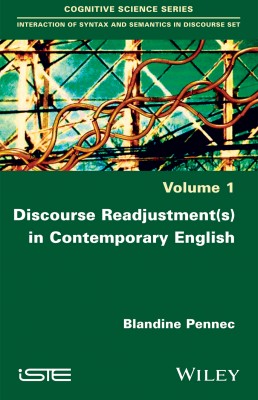
Inadequacies, approximations and ambiguities: this is the common batch of phenomena likely to hinder comprehension. Communication, and in particular oral communication, would in theory require many repetitions and preliminary tests in order to reach true accuracy or, at least, an adequacy between the wording and the intended meaning.
Nevertheless, languages offer us the chance to momentarily discard discursive linearity, and to give way to a reflexive view in order to go back on our words and amend them, to make changes in wording or enunciative perspectives. This book qualifies these reworkings as readjustments. The author examines, from a large corpus of contemporary English, phenomena of reformulation, of recentering on or distancing from a notion previously used, or of readjustments relating to the very structure of discourse. This book links the syntactic, enunciative and pragmatic levels.
Part 1. Definitions, Motivations and Typology of Discourse Readjustment Phenomena
1. Definitions: Mutual Intelligibility, Adjustment, Readjustment and Intersubjectivity.
2. Motivations Underpinning the Phenomena of Readjustment.
3. Typology of Readjustments.
Part 2. Reformulations: Readjustments to Express Oneself More Accurately?
4. The Function of Reformulations in the Framework of Language Activity and Discourse.
5. The Notion of Reformulation and its Linguistic Manifestations.
6. Paraphrastic or Non-paraphrastic Reformulations: Prototypical Introducers and Associated Strategies.
Part 3. Phenomena of Re-examination: Readjustments to Perfect One’s Stance?
7. Recentering: In fact and Competing Markers.
8. Upgrading and Downgrading: the Cases of Or even and Or at least.
9. Potential Upgrading: the Sequence If not.
Part 4. Distancing Processes: Readjustments for Changing Viewpoint?
10. Abandoning a First Enunciative Perspective: Examination of Anyway.
11. Disconnection and Renewed Stance: the Case of the Marker Now.
12. The Fixed Phrase After all, or Reconsidering a Viewpoint.
Part 5. Inserted Segments: Readjustments for Playing with Language?
13. The Use of Metalinguistic Expressions: Readjustments With Rhetorical Aim.
14. Readjustments in Parenthetical Form.
15. Dialogical Readjustments: Structures in It is not that.
Part 6. Readjustments Characteristic of Oral Discourse: Phenomena of Co-enunciative (Re)Structuring?
16. The Sequence I mean: From “Gap Filler” to Readjustment Marker.
17. Readjustments Calling on the Co-enunciator: You know and You see.
18. Expectations of the Co-enunciator: the Use of Mind you.
Blandine Pennec holds a PhD in English linguistics and is a senior lecturer authorized to supervise research. She teaches at the University of Toulouse – Jean Jaurès, France. Most of her research is in the area of enunciative linguistics and pragmatics.